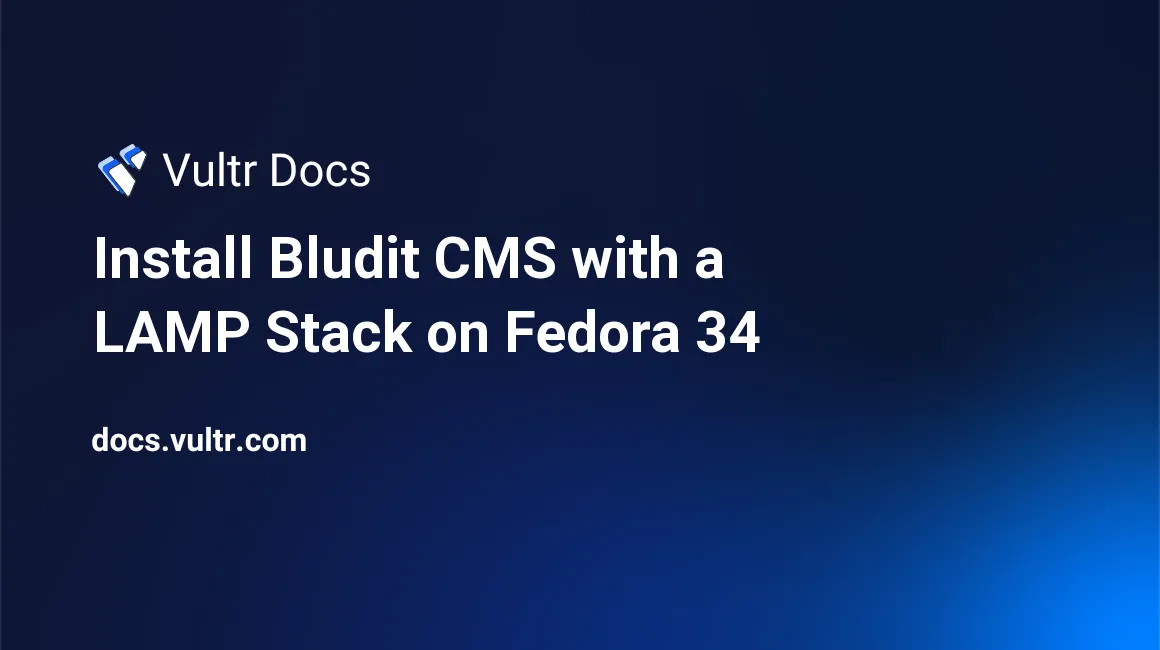
Introduction
Bludit is a simple, fast, and flexible flat-file content management system (CMS). It's free, and you can use it to create a personal blog/website within minutes. Because it doesn't require a database management system to work, Bludit is portable, and you can migrate it between servers. It has an intuitive interface and supports the Markdown language via plug-ins. You'll install the Bludit CMS with a LAMP Stack on your Fedora 34 server in this guide.
Prerequisites
To proceed with this tutorial, ensure you have the following.
- A Fedora 34 server
- A domain name such as example.com is optional. You can use your server's public IP address to test this guide.
- A non-root sudo user
- A LAMP Stack
1. Install the Dependencies
Ensure your system is up to date.
$ sudo dnf -y upgradeInstall some helper packages.
$ sudo dnf install -y unzip nano wgetInstall the required PHP extensions.
$ sudo dnf install -y php-cli php-fpm php-common php-mbstring php-gd php-xml php-jsonRestart your Apache webserver to load the new changes.
$ sudo systemctl restart httpd2. Download Bludit CMS
Apache serves your Bludit website from this location.
/var/www/Create a new bludit directory under it.
$ sudo mkdir -p /var/www/bluditNavigate to the tmp directory.
$ cd /tmpDownload the latest stable version of Bludit. Use the latest download link in place of the v3.13.1 link shown below.
$ wget https://www.bludit.com/releases/bludit-3-13-1.zipAfter downloading the package, unzip it to your current working directory.
$ sudo unzip bludit-3-13-1.zipCopy the Bludit source files to the /var/www/bludit/ directory.
$ sudo rsync -rtv bludit-3-13-1/ /var/www/bludit/Assign the ownership of the /var/www/bludit to the apache user.
$ sudo chown -R apache:apache /var/www/bluditEnsure the files have the appropriate permissions.
$ sudo chmod -R 755 /var/www/bludit3. Disable SELinux
Edit the SELinux configuration file.
$ sudo nano /etc/selinux/configLocate the line SELINUX=enforcing as shown below.
...
SELINUX=enforcing
...Change the value of SELINUX from enforcing to disabled to disable SELinux.
...
SELINUX=disabled
...Save and exit the file.
Reboot your server.
$ sudo reboot4. Create a Virtual Host File
Create a new virtual host configuration file under /etc/httpd/conf.d.
$ sudo nano /etc/httpd/conf.d/bludit.confEnter the information below into the file. Remember to replace example.com and webmaster@example.com with your information.
<VirtualHost *:80>
ServerAdmin webmaster@example.com
ServerName example.com
DocumentRoot /var/www/bludit
<Directory /var/www/bludit>
Options Indexes FollowSymLinks
AllowOverride All
Order allow,deny
Allow from all
</Directory>
</VirtualHost>Save and close the file.
Restart Apache to load the new configuration.
$ sudo systemctl restart httpd5. Complete the Bludit Installation
Visit your server's installation URL. Replace example.com with the correct domain name or IP address of your web server.
http://example.com/install.phpFollow the on-screen prompt to choose a language.
Click Next.
Create a password for the admin account.
Click Install.
After you complete the installation procedure, log in to your Bludit website.
Conclusion
You've set up a Bludit website with a LAMP Stack on a Fedora 34 server in this tutorial. You can now customize your site by adding content and activating the necessary plug-ins depending on your needs.
No comments yet.